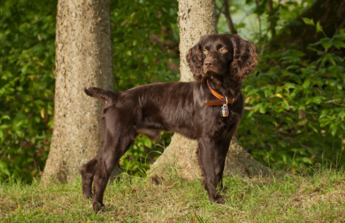Labs are easy-care dogs who don’t need lots of fancy grooming, but there are a few important things to know about their care.
Labs shed a lot. You’ll have less hair lying around the house if you brush your Lab once or twice a week so that the hair goes onto the brush instead of onto your furniture and clothes. A rubber curry brush and a metal shedding blade or wire slicker brush are your new best friends.
Labs are water dogs. When your Lab gets wet, and he will, give him a thorough freshwater rinse to remove chlorine, salt or lake muck from his fur, all of which can be drying or otherwise damaging to the coat.
Moisture in the ears can increase the risk of ear infections -- especially in a breed already prone to them (due primarily to allergies). Dry the ears thoroughly after a swim, and use an ear cleaner recommended by your veterinarian.
The rest is basic maintenance. Trim the nails every week or two, as needed. They should never get long enough that you hear them clacking on the floor. Long nails can make it uncomfortable for the Lab to walk, and they can get caught on things and tear off. That’s really painful, and it will bleed a lot. Brush the teeth frequently with a vet-approved pet toothpaste for gooddental healthand fresh breath.
The Labrador Retriever is an exuberant, very energetic breed that needs lots ofexercisesevery day. A Lab who doesn’t get enough exercise is likely to engage in hyperactive and/or destructive behavior to release pent-up energy.
The breed’s favorite activities are retrieving and swimming. Labs also love to burn up energy on hunting trips or atfield trials, as well as by participating in canine sports such asagility,obedience,tracking, and dock diving.
Many Labs also work hard in important roles such as search-and-rescue, drug and bomb detection, and as service and assistance dogs.
Labrador Retrievers tend to be more active, larger dogs and consequently need a fair amount of food in comparison with many dogs. Without plenty of activity, it is common for people to overfeed a Labrador Retriever and this leads to seeing plenty of overweight Retrievers.
Although Labrador Retrievers are a larger breed of dog, it’s important to remember that they still should only get to around 80 pounds on the higher end for males and 70 pounds for the females. Many people are tempted to feed their Retriever like they’re another person in the home, but keep in mind that even an adult Retriever is typically just half the size of an average adult human.
Like with many dogs, meats are popular as well as vegetables and many types of all-purpose dog food can be considered suitable for Labrador Retrievers.
In addition to a few inherited disorders such as cataracts and hip andjoint problems, Labrador Retrievers are susceptible to obesity if they do not receive a proper diet and a healthy amount of exercise.
Your Labrador Retriever’s health problems are likely to include joint issues, particularly if your dog is overweight and has been for a period of time.
Considered versatile, Labrador Retrievers can put up with a lot of training and generally respond well to behavior training.
They are not excessively territorial or aggressive despite its large size and will often respond with all of the loyalty and obedience as you’re capable of giving.
For people who aren’t interested in doing a lot of training on their dog, a Labrador Retriever makes an ideal dog because it will not always require a lot of work to keep it within the bounds of acceptable behavior. This isn’t to say that all Labrador Retrievers will respond this way, however.
Puppy training classes serve as part of the socialization process and help the owner learn to recognize and correct any bad habits that may be developing. Labs are devoted, intelligent, and enthusiastic companions who need to be included in family activities.












